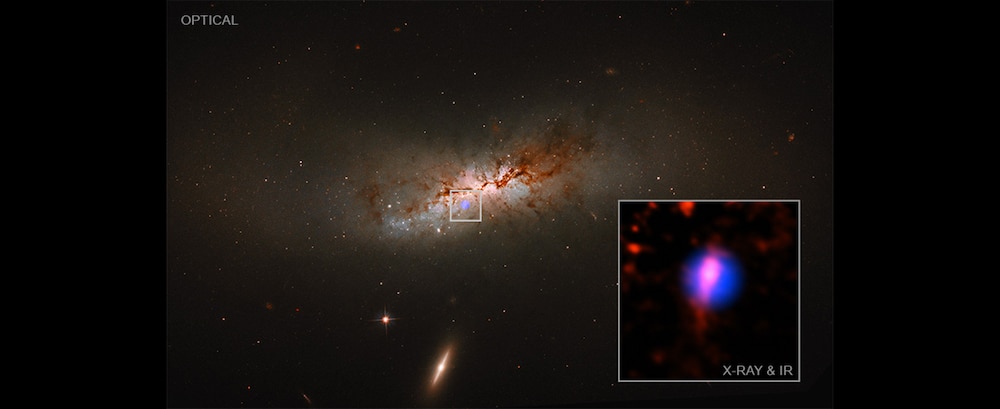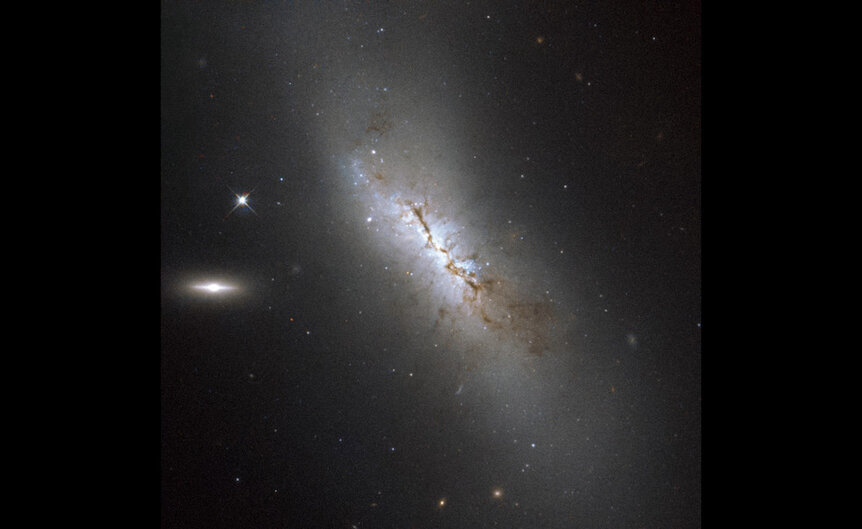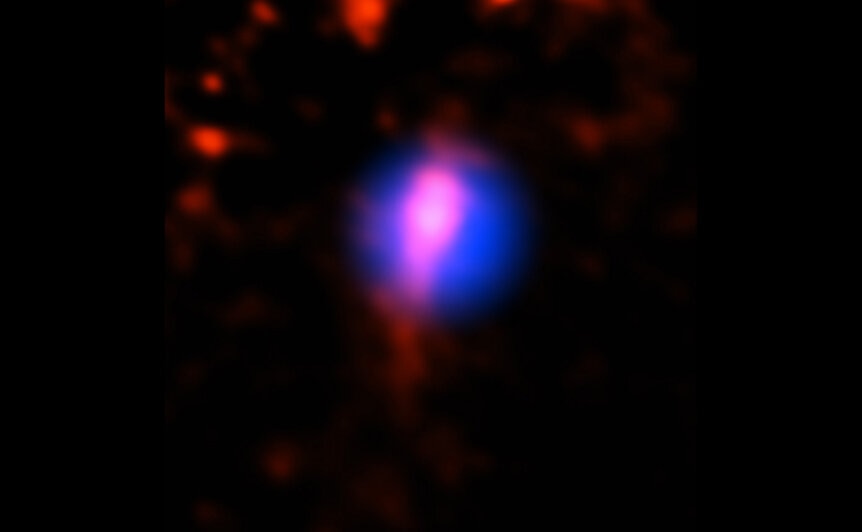Create a free profile to get unlimited access to exclusive videos, sweepstakes, and more!
Black hole delivery pipeline may feed a nearby galaxy
A medium-sized black hole is headed directly toward another medium-sized black hole.

Astronomers have found what looks like a delivery system for a beefy black hole pointing straight at the center of a galaxy, and in a couple of hundred million years there could be quite the encounter when it gets there.
The galaxy is NGC 4424, an odd little thing about halfway out from the center of the Virgo Cluster, a collection of over a thousand galaxies located about 60 million light-years from Earth. NGC 4424 is a bit closer than the cluster center, perhaps 54 million light-years from us. It’s a spiral galaxy something like our Milky Way, but smaller and with fewer stars — it has perhaps a few dozen billion stars in it, while ours has more like a trillion.
It’s a flattish disk that we see not-quite edge-on, and it’s laced with silhouetted lanes of opaque dust that block starlight from behind them. The shape and structures seen strongly imply that NGC 4424 had an encounter with another, yet even smaller galaxy some hundreds of millions of years ago. The gravitational interaction between the two disturbed the disk and spiral of the bigger galaxy, and it’s still recovering even today.
But that’s not all that’s odd. Sitting very close to but not precisely at the center is a source of high-energy X-rays. Numerous phenomena can create these, though whatever this one is in X-rays alone it’s shining over a hundred thousand times the brightness of the Sun at all wavelengths. That takes a powerful source: Some sort of black hole, with material falling into it. This process is a well-known source of X-rays.
Ah, but the plot thickens. Looking at a Hubble Space Telescope image taken a few years back, a team of astronomers used a model of galactic structure to subtract away the annoyingly bright background surrounding the nucleus of NGC 4424 [link to paper]. They found an interesting structure: An extended streak of reddish stars, several hundred light-years long, about a thousand light-years from the center of the galaxy. Fairly close.
The source of X-rays sits exactly on top of the streak.
That can’t be coincidence. What the astronomers posit is that the streak is actually a cluster of stars, the remains of a smaller galaxy that had a close pass with NGC 4424 some time ago, and is very likely the perp in the encounter that disturbed the bigger galaxy’s structure. And while NGC 4424 was stirred up by the encounter, the smaller galaxy was picked nearly clean by it.
When a small galaxy passes very close to a bigger one, the gravity of the more massive galaxy can strip stars from the smaller one. Under favorable conditions, which could include multiple passes, the small galaxy can have nearly all its stars ripped away from it.
Nearly. Many galaxies have a tightly packed collection of stars in their cores, called a nuclear star cluster. They are so close to each other that their gravitational attraction is strong, and can withstand the larger galactic collision. But even then they can be stretched, elongated, forming a streak of stars that can be hundreds of light-years long.
That is what the astronomers think they have seen: The core cluster of a small galaxy torn apart by NGC 4424. They nicknamed it Nikhuli, after a festival by the Sumi people of Nagaland, a state in northeast India, wishing for a bountiful harvest. They estimate Nikhuli has something like 10 million stars in it.
But there’s more: Many galaxies have massive black holes in their cores, some up to billions of times the mass of the Sun, but most far smaller. In general the mass of the black hole scales with the mass of the galaxy; smaller galaxies have smaller black holes. Nuclear star clusters are often associated with black holes, enough that this mass relationship can be used; they find the black hole in Nikhuli, if it exists, would have about 70,000 solar masses.
Black holes of this size are called intermediate mass black holes, and are likely very common, though difficult to detect. As of right now, none has ever been verified, though dozens of candidates exist. But if there’s a source of matter like gas from stars orbiting it, that material can fall toward the black hole, heat up, and emit X-rays.
Such a black hole may be in the center of NGC 4424 as well. No X-rays are detected coming from it, but judging by the mass of the galaxy and the velocities of the stars in its center, a black hole there could be around 100,000 solar masses, making it an intermediate mass one as well.
The astronomers estimate the initial encounter between the two galaxies started some 600 million or more years ago, and, assuming Nikhuli is headed directly toward the center of NGC 4424, there’s another 200 million years to go before it gets there.
If there’s a black hole lurking there, the two will likely go into orbit around one another, eventually spiraling together and merging billions of years hence. When they do they’ll erupt in a blast of gravitational waves that would be easily detectable from Earth. Assuming anyone is here to look for them.
If this scenario is accurate, it provides insight on how central massive black holes grow. We know galaxies collide, and we know most have big black holes. We strongly suspect supermassive black holes grow to their huge sizes by eating smaller ones, but we have yet to observe every step in this process. If Nikhuli is on course to feed NGC 4424’s central black hole, then its name is appropriate, as it will bring a harvest right into the maw of the bigger galaxy.
It’s likely this phenomenon is common; many small galaxies are stripped by collisions, leaving behind nuclear star clusters surrounding black holes. Galaxy clusters are good hunting grounds for such beasts since there are so many galaxies so close together. The astronomers plan on looking more carefully at over 70 more Virgo Cluster denizens to see if they too are about to receive a black hole bounty. If so, then we are about to learn a lot more about this process.





























